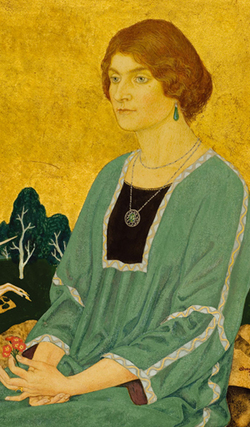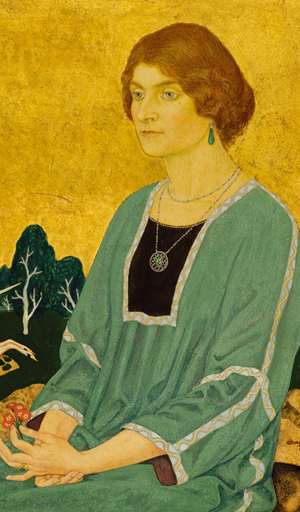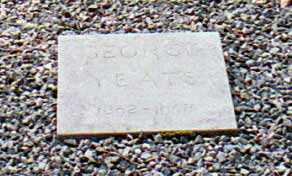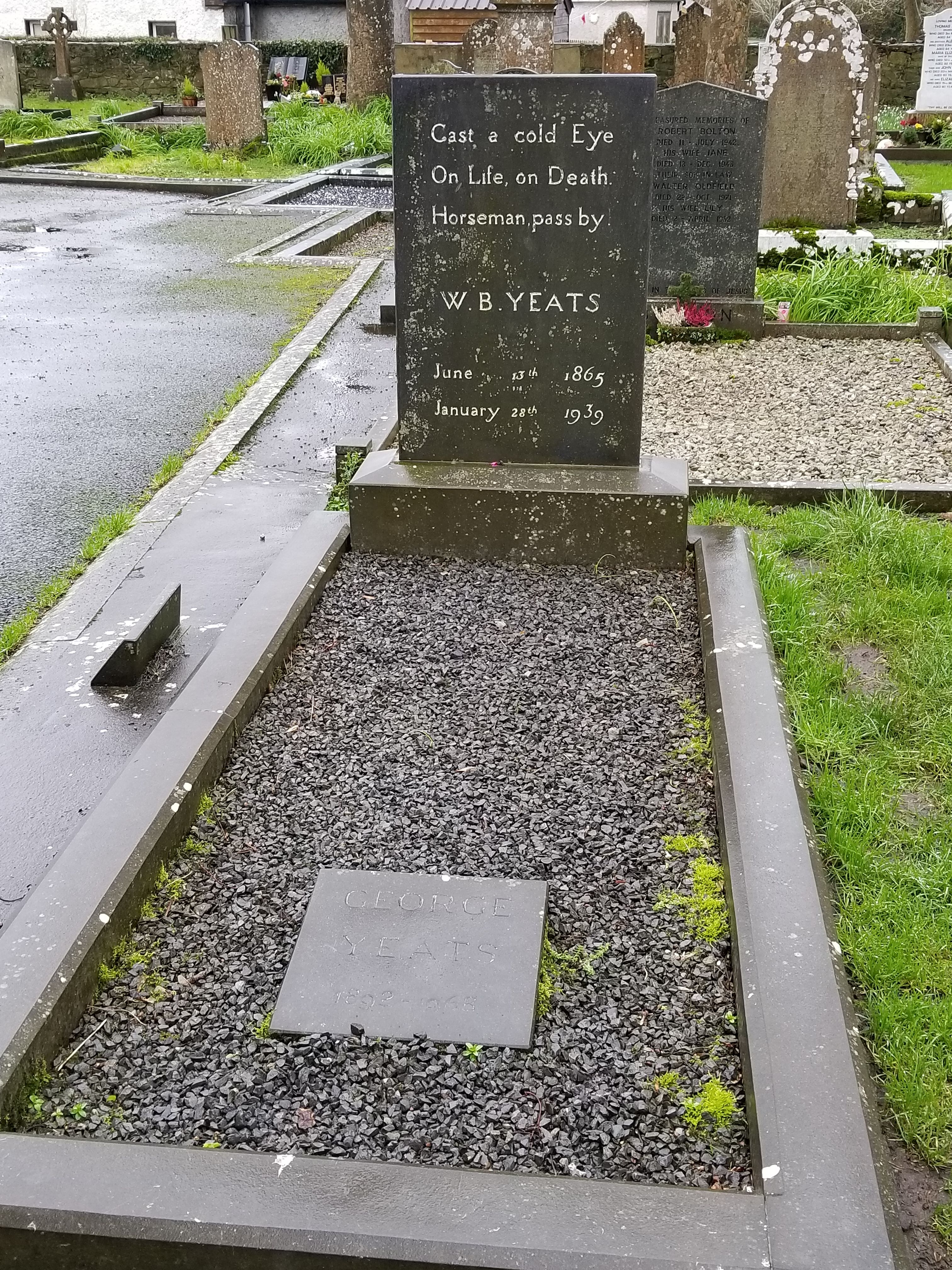A finacialy secure young woman due to her father's wealth, Georgie spoke 5 languages fluently and her social environment was the rarefied atmosphere of England's literary & artistic elites. She first met the poet William Butler Yeats when she was 18, as they had the same friends and moved in the same circles.
After having been acquaintances for 7 years, Yeats discussed marriage with her. Weeks later, in October 1917, they wed in London. Ezra Pound, who was married to Georgie's best friend, was the best-man. At the time of their marriage, Wily, as he was called, was 52, Georgie was 25.
While on their honeymoon, Georgie, who Yeats rechristened 'George', experimented with automatic writing. Also called Script, it's a process wherein one lets go of conscious thought and, loosely holding a pen over a piece of paper, scribbles messages from the spirit world. It was George's automatic writing that inspired Yeats' work A Vision and their spiritual collaboration that propelled Yeats to greater heights in the prolific latter half of his career.
The Yeats' had 2 children together, Anne in 1919 and their son Michael Butler in 1921. They made their home and raised their children in Ireland, as it was at George's inclination that her husband moved back to Dublin after their marriage. She supported and encouraged his growing nationalism after the Easter Rising, of which he famously wrote:
MacDonagh and MacBride
And Connolly and Pearse
Now and in time to be,
Wherever green is worn,
Are changed, changed utterly:
A terrible beauty is born.
George's impact on Yeats work was so profound, the preeminent biographer of Irish writers, Richard Ellmann, wrote "Had Yeats died instead of marrying in 1917, he would have been remembered as a remarkable minor poet who achieved a diction more powerful than that of his contemporaries but who, except in a handful of poems, did not have much to say with it"
W. B. Yeats died in France in 1939 and was buried at a hilltop cemetery near the French Riviera. At George's direction, he was re-interred at Drumcliff Churchyard in Sligo in 1948. His remains were returned to Ireland by An tSeirbhís Chabhlaigh and the State Funeral that followed was an event of national significance and import.
It was Yeats' own wish to rest in Sligo, as he made clear in the last stanza of the poem Under Ben Bulben:
Under bare Ben Bulben's head
In Drumcliff churchyard Yeats is laid.
An ancestor was rector there
Long years ago, a church stands near,
By the road an ancient cross.
No marble, no conventional phrase;
On limestone quarried near the spot
By his command these words are cut:
Cast a cold eye
On life, on death.
Horseman, pass by!
George was the custodian and literary executor of her husband Wily's papers for 30 years after his death. She is remembered in these decades as being encouraging and generous to scholars and publishers of Yeats' body of work, yet it was she alone who decided what would and what would not be released, and to whom access would be granted.
She edited her husband's works and collaborated on the first official Yeats' biography and on the publication of his letters and bibliography. Until age and failing health interfered, she read, reviewed and commented on nearly all of the critical manuscripts and editions of Yeats' literary output.
George passed away at the age of 76 at her home in Rathmines, her reputation as one of the literature world's most significant and famous figures secure. She bequeathed W. B. Yeats' manuscripts and papers to the Irish nation, a gift that is a national treasure.
✞ George Yeats is buried with William Butler Yeats, her husband of 22 years, at Drumcliff Churchyard in Sligo.
A finacialy secure young woman due to her father's wealth, Georgie spoke 5 languages fluently and her social environment was the rarefied atmosphere of England's literary & artistic elites. She first met the poet William Butler Yeats when she was 18, as they had the same friends and moved in the same circles.
After having been acquaintances for 7 years, Yeats discussed marriage with her. Weeks later, in October 1917, they wed in London. Ezra Pound, who was married to Georgie's best friend, was the best-man. At the time of their marriage, Wily, as he was called, was 52, Georgie was 25.
While on their honeymoon, Georgie, who Yeats rechristened 'George', experimented with automatic writing. Also called Script, it's a process wherein one lets go of conscious thought and, loosely holding a pen over a piece of paper, scribbles messages from the spirit world. It was George's automatic writing that inspired Yeats' work A Vision and their spiritual collaboration that propelled Yeats to greater heights in the prolific latter half of his career.
The Yeats' had 2 children together, Anne in 1919 and their son Michael Butler in 1921. They made their home and raised their children in Ireland, as it was at George's inclination that her husband moved back to Dublin after their marriage. She supported and encouraged his growing nationalism after the Easter Rising, of which he famously wrote:
MacDonagh and MacBride
And Connolly and Pearse
Now and in time to be,
Wherever green is worn,
Are changed, changed utterly:
A terrible beauty is born.
George's impact on Yeats work was so profound, the preeminent biographer of Irish writers, Richard Ellmann, wrote "Had Yeats died instead of marrying in 1917, he would have been remembered as a remarkable minor poet who achieved a diction more powerful than that of his contemporaries but who, except in a handful of poems, did not have much to say with it"
W. B. Yeats died in France in 1939 and was buried at a hilltop cemetery near the French Riviera. At George's direction, he was re-interred at Drumcliff Churchyard in Sligo in 1948. His remains were returned to Ireland by An tSeirbhís Chabhlaigh and the State Funeral that followed was an event of national significance and import.
It was Yeats' own wish to rest in Sligo, as he made clear in the last stanza of the poem Under Ben Bulben:
Under bare Ben Bulben's head
In Drumcliff churchyard Yeats is laid.
An ancestor was rector there
Long years ago, a church stands near,
By the road an ancient cross.
No marble, no conventional phrase;
On limestone quarried near the spot
By his command these words are cut:
Cast a cold eye
On life, on death.
Horseman, pass by!
George was the custodian and literary executor of her husband Wily's papers for 30 years after his death. She is remembered in these decades as being encouraging and generous to scholars and publishers of Yeats' body of work, yet it was she alone who decided what would and what would not be released, and to whom access would be granted.
She edited her husband's works and collaborated on the first official Yeats' biography and on the publication of his letters and bibliography. Until age and failing health interfered, she read, reviewed and commented on nearly all of the critical manuscripts and editions of Yeats' literary output.
George passed away at the age of 76 at her home in Rathmines, her reputation as one of the literature world's most significant and famous figures secure. She bequeathed W. B. Yeats' manuscripts and papers to the Irish nation, a gift that is a national treasure.
✞ George Yeats is buried with William Butler Yeats, her husband of 22 years, at Drumcliff Churchyard in Sligo.
Bio by: David Conway
Inscription
GEORGE
YEATS
1892 - 1968
Cast a cold Eye
On Life, on Death.
Horseman, pass by!
W. B. YEATS
June 13th 1865
January 28th 1939










